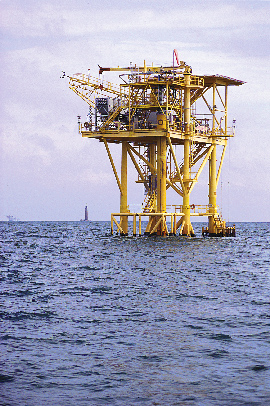Rig rockin’
Oil-rig legs hold an entire ecosystem of marine life, which correlates into a kingfish feeding frenzy

They weren’t built for angling enhancement, but the numerous petroleum and natural-gas platforms dotting the northern Gulf of Mexico are undoubtedly the most influential habitat element for area kingfishing. Size and shape varies with function, but from Alabama to Texas, the word “rig” covers it all.
The allure of a rig is simple – food. The legs of these massive monuments hold entire ecosystems of marine vegetation, crustaceans and small fish, providing perpetual feeding stations for larger predators. Late spring and summer sees the most intense action, but the ever-present food sources mean year-round kingfish action.
Making big laps around a rig will occasionally put you in the strike zone, but locating the sweet spot means finding the food sources. Generally, bait schools hang on a rig’s upcurrent side. When it’s hot, you’ll find the bait closer to the rig, in its shadows.
It’s important to note that a rig’s legs don’t run vertically to the bottom. Rather, they stand at an angle and can extend 100 feet or more from the platform’s outer edges. Therefore, trolling too close with downriggers can cause snagging. Fortunately, hooked kings don’t intentionally run for the rig’s legs, like an amberjack or cobia. Structure proximity presents a constant break-off hazard, however, so it’s crucial to stay on top of your fish to keep lines clear.
Rig productivity relates directly to food density, so look for topside action such as spadefish amassing near the legs and blue runners chasing smaller forage fish. The latter will froth the surface in areas as large as a football field, and sudden streaks of white water or cannonball explosions indicate the presence of feeding kingfish.
Blue runners rank high in kingfish preference, so anglers are wise to load their livewells with these hefty baits. Trolling around the schools or casting into their midst with small silver spoons or jigs are popular tactics. Gold-hook sabiki rigs will also snare runners. Go with heavier models, as many of the baitfish weigh 2 pounds or better. Other common rig baits include bluefish, white trout, pogies (menhaden) and dead ribbonfish.
In most areas, the sharp-eyed kingfish will spot and avoid oversized tackle, but this axiom’s applicability decreases in the northern Gulf. Not that kings completely lose their apprehension around the rigs, but your chances of connecting with a monster are higher than anywhere else the fish roam. Plus, the combination of often turbid water and high-feeding competition in a defined area equals jacked-up fish that bite first and ask questions later.
A standard rig-fishing setup comprises a 2-foot No. 6 wire leader and a 5/0 live-bait lead hook trailing 6 to 8 inches of No. 7 wire with a No. 1 treble “stinger.” For larger baits, use multiple stinger segments to ensure a hookup, no matter where a kingfish bites. Stop your quarry with stout, fast-tipped 7- to 8-foot rods carrying high-speed reels loaded with at least 350 yards of 30-pound line.
For navigational purposes, each rig bears an identification plate indicating its owner (abbreviated), block and number. The northern Gulf drilling fields are divided into geographic blocks such as Grand Isle (GI), West Delta (WD) and South Pass (SP). Matching this info to the grids of a “block chart” enables anglers to reach distant rigs, even without electronics.
Keep watch for approaching crew boats that shuttle supplies and personnel to and from the structures. Crew-boat skippers are accustomed to fishing boats, and most are fairly patient with a hooked-up kingfish team doing its best to clear out. All others must give way immediately